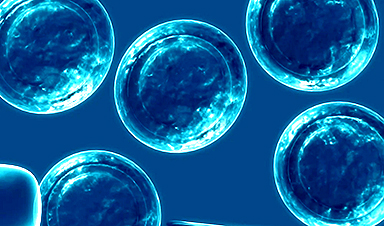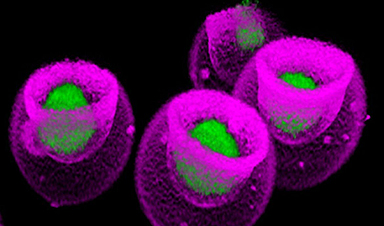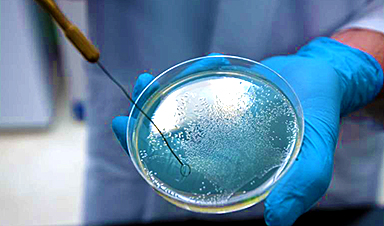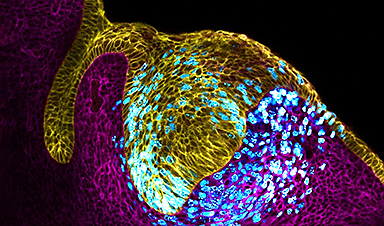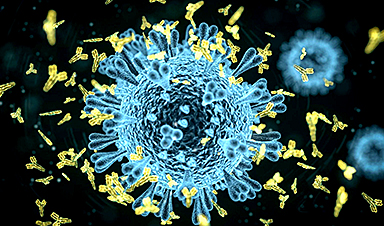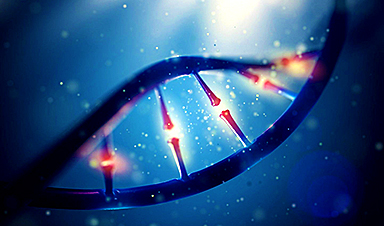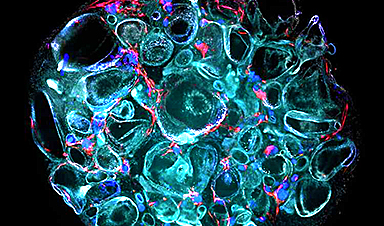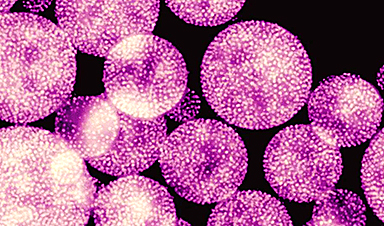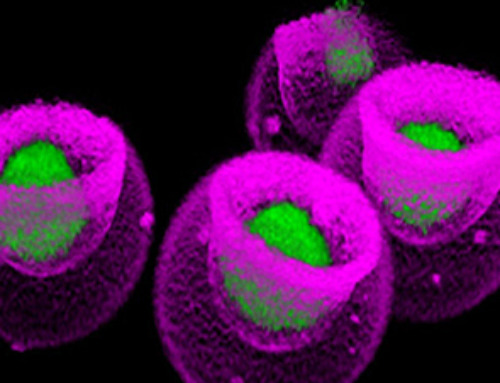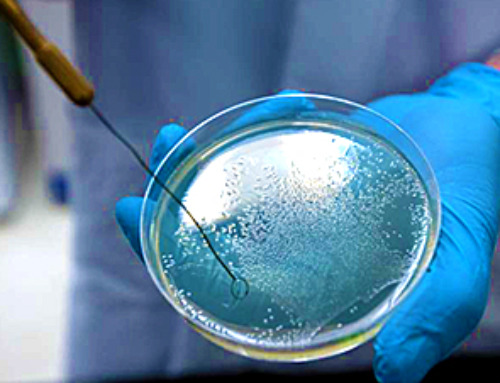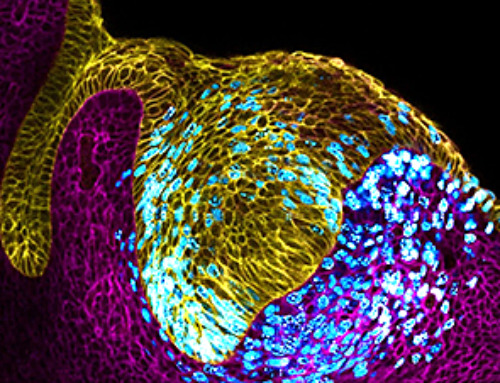| Using nanopore DNA sequencing technology, researchers from TU Delft and the University of Illinois have managed to scan a single protein: by slowly moving a linearized protein through a tiny nanopore, one amino acid at the time, the researchers were able to read off electric currents that relate to the information content of the protein. | |
| The researchers published their proof-of-concept in Science (“Multiple re-reads of single proteins at single-amino-acid resolution using nanopores”). The new single-molecule peptide reader marks a breakthrough in protein identification, and opens the way towards single-molecule protein sequencing and cataloguing the proteins inside a single cell. |
| Proteins are the workhorses of our cells, yet we simply don’t know what proteins we all carry with us. A protein is a long peptide string made of 20 different types of amino acids, comparable to a necklace with different kinds of beads. From the DNA blueprint, we are able to predict of which amino acids a protein consists. | |
| However, the final protein can greatly differ from the blueprint, for example due to post-translational modifications. Current methods to measure proteins are expensive, limited to large volumes, and they cannot detect many rare proteins. | |
| With nanopore-based technology, one is already able to scan and sequence single DNA molecules. The team led by Cees Dekker (TU Delft) now adapted this technique to instead scan a single protein, one amino acid at a time. | |
| “Over the past 30 years, nanopore-based DNA sequencing has been developed from an idea to an actual working device,” Cees Dekker explains. “This has even led to commercial hand-held nanopore sequencers that serve the billion-dollar genomics market. In our paper, we are expanding this nanopore concept to the reading of single proteins. This may have great impact on basic protein research and medical diagnostics.” | |
Like beads down the drain |
|
| The new technique reveals characteristics of even single amino acids within a peptide, but how? Lead author of the paper Henry Brinkerhoff, who pioneered this work as a postdoc in Dekker’s lab, explains: “Imagine the string of amino acids in one peptide molecule as a necklace with different-sized beads. Then, imagine you turn on the tap as you slowly move that necklace down the drain, which in this case is the nanopore. If a big bead is blocking the drain, the water flowing through will only be a trickle; if you have smaller beads in the necklace right at the drain, more water can flow through. With our technique we can measure the amount of water flow (the ion current actually) very precisely.” | |
| Cees Dekker enthusiastically adds: “A cool feature of our technique is that we were able to read a single peptide string again and again: we then average all the reads from that one single molecule, and thus identify the molecule with basically 100% accuracy.” | |
| This results in a unique read-off which is characteristic for a specific protein. When the researchers changed even one single amino acid within the peptide (‘a single bead within the necklace’), they obtained very different signals, indicating the extreme sensitivity of the technique. The group led by Alek Aksimentiev at the University of Illinois performed molecular dynamics simulations that showed how the ion current signals relate to the amino acids in the nanopore. | |
Scanning the barcode for identification |
|
| The new technique is very powerful for identifying single proteins and mapping minute changes between them – much like how a cashier in the supermarket identifies each product by scanning its barcode. It also may provide a new route towards full de novo protein sequencing in the future. | |
| Henry Brinkerhoff clarifies: “Our approach might lay a basis for a single-protein sequencer in the future, but de novo sequencing remains a big challenge. For that, we still need to characterize the signals from a huge number of peptides in order to create a ‘map’ connecting ion current signals to protein sequence. Even so, the ability to discriminate of single-amino-acid substitutions in single molecules is a major advance, and there are many immediate applications for the technology as it is now…..” |
News
How Are Hydrogels Shaping the Future of Biomedicine?
Hydrogels have gained widespread recognition and utilization in biomedical engineering, with their applications dating back to the 1960s when they were first used in contact lens production. Hydrogels are distinguished from other biomaterials in [...]
Nanovials method for immune cell screening uncovers receptors that target prostate cancer
A recent UCLA study demonstrates a new process for screening T cells, part of the body's natural defenses, for characteristics vital to the success of cell-based treatments. The method filters T cells based on [...]
New Research Reveals That Your Sense of Smell May Be Smarter Than You Think
A new study published in the Journal of Neuroscience indicates that the sense of smell is significantly influenced by cues from other senses, whereas the senses of sight and hearing are much less affected. A popular [...]
Deadly bacteria show thirst for human blood: the phenomenon of bacterial vampirism
Some of the world's deadliest bacteria seek out and feed on human blood, a newly-discovered phenomenon researchers are calling "bacterial vampirism." A team led by Washington State University researchers has found the bacteria are [...]
Organ Architects: The Remarkable Cells Shaping Our Development
Finding your way through the winding streets of certain cities can be a real challenge without a map. To orient ourselves, we rely on a variety of information, including digital maps on our phones, [...]
Novel hydrogel removes microplastics from water
Microplastics pose a great threat to human health. These tiny plastic debris can enter our bodies through the water we drink and increase the risk of illnesses. They are also an environmental hazard; found [...]
Researchers Discover New Origin of Deep Brain Waves
Understanding hippocampal activity could improve sleep and cognition therapies. Researchers from the University of California, Irvine’s biomedical engineering department have discovered a new origin for two essential brain waves—slow waves and sleep spindles—that are critical for [...]
The Lifelong Cost of Surviving COVID: Scientists Uncover Long-Term Effects
Many of the individuals released to long-term acute care facilities suffered from conditions that lasted for over a year. Researchers at UC San Francisco studied COVID-19 patients in the United States who survived some of the longest and [...]
Previously Unknown Rogue Immune Key to Chronic Viral Infections Discovered
Scientists discovered a previously unidentified rogue immune cell linked to poor antibody responses in chronic viral infections. Australian researchers have discovered a previously unknown rogue immune cell that can cause poor antibody responses in [...]
Nature’s Betrayal: Unmasking Lead Lurking in Herbal Medicine
A case of lead poisoning due to Ayurvedic medicine use demonstrates the importance of patient history in diagnosis and the need for public health collaboration to prevent similar risks. An article in CMAJ (Canadian Medical Association [...]
Frozen in Time: How a DNA Anomaly Misled Scientists for Centuries
An enormous meteor spelled doom for most dinosaurs 65 million years ago. But not all. In the aftermath of the extinction event, birds — technically dinosaurs themselves — flourished. Scientists have spent centuries trying [...]
‘Mini kidneys’ reveal new insights into metabolic defects in polycystic kidney disease
Scientists at Nanyang Technological University, Singapore (NTU Singapore) have successfully grown 'mini kidneys' in the lab and grafted them into live mice, revealing new insights into the metabolic defects and a potential therapy for [...]
Decoding the Origin of Life: Scientists Solve Early Earth RNA Puzzle
Recent research illustrates how RNA molecules’ chemical characteristics might have played a crucial role in the development of complex life forms. How did complex life manage to evolve on the early, inhospitable Earth? Initially, [...]
Improving infectious disease testing with gold nanoparticles
By harnessing the power of composite polymer particles adorned with gold nanoparticles, a group of researchers have delivered a more accurate means of testing for infectious diseases. Details of their research was published in the [...]
New micromaterial releases nanoparticles that selectively destroy cancer cells
Researchers have developed micromaterials made up only of proteins, capable of delivering over an extended period of time nanoparticles that attack specific cancer cells and destroy them. The micromaterials mimic natural secretory granules found [...]
Alzheimer’s Breakthrough: Scientists Make Revolutionary Leap
Dementia is a major health issue worldwide in the 21st century, impacting over 50 million people globally. This figure is expected to soar to 152 million by 2050, as the global population ages. Alzheimer’s disease (AD) [...]

